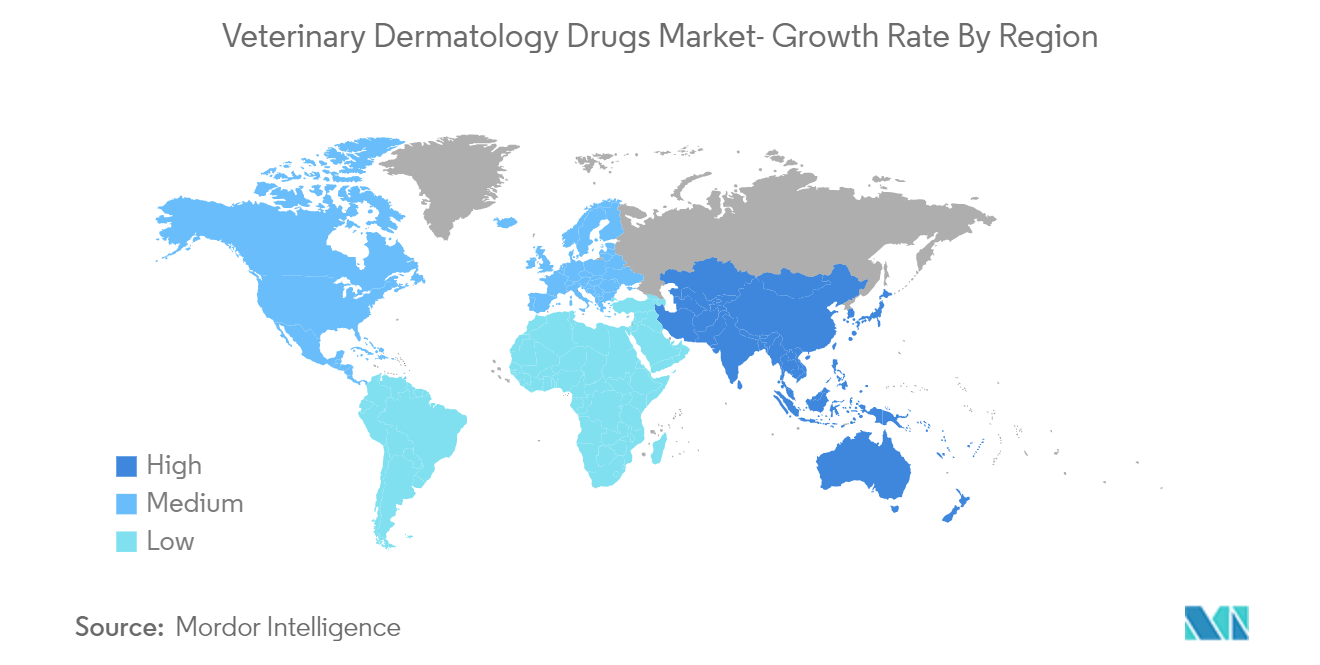Market Trends of Global Veterinary Dermatology Drugs Industry
Companion Animal Segment is Expected to have Significant Growth Over the Forecast period
The companion animal segment is likely to witness significant growth during the forecast period. The demand for companion animal dermatological drugs has been observing a significant rise in the global market, owing to factors such as increasing pet adoption, rising prevalence of companion animal diseases, and rising awareness about companion animal health.
According to the annual report of the FEDIAF in July 2022, cats and dogs are the most popular companion animals in Europe, with 26% of all pet-owning households owning a cat, amounting to 110 million household cats, and 25% owning dogs, amounting to 90 million dogs. As per the above source, Russia has the most cats (22.9 million), followed by Germany (16.7 million) and France (15.1 million). Russia also has the most dogs, with 17.5 million, followed by the United Kingdom with 12.0 million and Germany with 10.3 million in 2021. This is likely to lead to more dermatological care for pet animals since skin infections and diseases are the most common health problems in companion animals. Hence it is anticipated to fuel the segment's growth.
Furthermore, similar to human allergies, canine allergies, such as atopic dermatitis (AD), are becoming more common. Chronic allergies are characterized by pruritus and recurring inflammatory lesions. For instance, as per a research article published by MDPI in December 2022, concerns regarding canine health have grown along with the large growth in the number of dog owners in recent years. Dogs typically attend veterinary clinics for skin illnesses, including allergies, infections, and endocrine issues. Hence, the rising burden of skin diseases in pets likely increases the demand for dermatology drugs for treatment and is expected to drive the growth of the segment.
Moreover, new product launches by market players for companion animals play a major role in the growth of the market. For example, in October 2023, Pet King Brands, Inc. added three new products to the line of veterinarian-recommended ZYMOX Enzymatic Dermatology products to help cats and kittens with problems with their ears and skin. These new product launches increase the product portfolios of major players in veterinary dermatology drugs and will drive the market over the forecast period.

North America is Expected to Hold a Significant Share in the Market Over the Forecast Period
North America is anticipated to witness a high growth rate in the veterinary dermatology drugs market during the forecast period, owing to the high prevalence of pruritus, sores, alopecia, masses, eruptions, scales, seborrhea, pustules, and draining tracts in animals.
The growth of the veterinary dermatology drugs market in developed countries such as the United States and Canada is driven by increased pet adoption, awareness about animal health, and animal health expenses.According to data from the Canadian Animal Health Institute (CAHI) in September 2022, more than half of Canadian households (60%) own at least one dog or cat in 2022. Additionally, the dog population increased to 7.9 million, and the cat population increased to 8.5 million in the same year.
In the North American region, the United States is expected to hold a significant share of the veterinary oncology market due to having one of the highest numbers of animals in the region, coupled with high animal health expenditure and a high burden of animal cancer cases. According to the 2023-2024 American Pet Product Association (APPA) National Pet Owners Survey, about 66% of households in the United States owned a pet, which translates to about 86.9 million homes. Cats and dogs were the major pets, with a total population of 45.3 million and 69 million, respectively. Hence, increasing pet adoption along with rising expenditure on the healthcare of animals, which also includes veterinary dermatological disease management, is expected to drive the market in the region.
The major players are actively making strategic plans and new developments, along with new product approvals and launches, to contribute to the market. For instance, in November 2022, Vetoquinol Canada announced that veterinarians across the country now have a new tool available to try and address many of today’s challenges in the field of pet dermatology. Owing to the increasing number of recent developments and new product launches by market players, the North American region for the studied market is growing faster and will witness a prominent growth rate during the forecast period for the veterinary dermatology drugs market.


